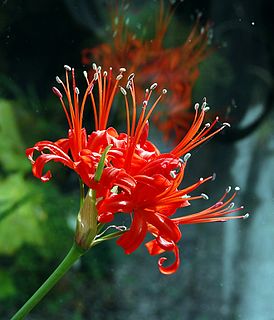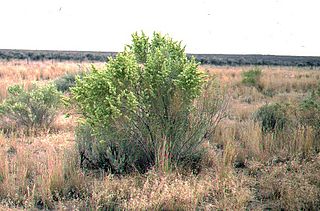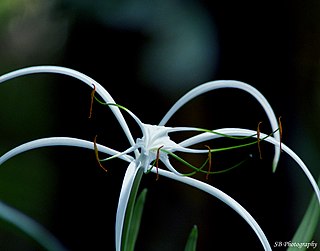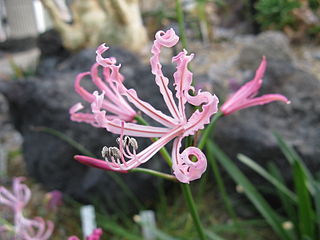
Hydrangea common names hydrangea or hortensia, is a genus of over 75 species of flowering plants native to Asia and the Americas. By far the greatest species diversity is in eastern Asia, notably China, Korea, and Japan. Most are shrubs 1–3 m tall, but some are small trees, and others lianas reaching up to 30 m (100 ft) by climbing up trees. They can be either deciduous or evergreen, though the widely cultivated temperate species are all deciduous.
Wild ginger may refer to any of a variety of plants, often with a similar appearance, odour or taste to cultivated ginger. Species involved include:

Nerine sarniensis, commonly known as Guernsey lily or Jersey lily, is a species of flowering plant in the family Amaryllidaceae. It is the type species of the Nerine genus. It is widely cultivated in the temperate world and is particularly associated with the island of Guernsey, as reflected in both its Latin and common names, though it does not originate there, nor is it a true lily. It is native to the Northern and Western Cape Provinces of South Africa, though it is now naturalized in France, Madeira and the Azores.

Saltbush is a vernacular plant name that most often refers to Atriplex, a genus of about 250 plants distributed worldwide from subtropical to subarctic regions. Atriplex species are native to Australia, North and South America, and Eurasia. Many Atriplex species are halophytes and are adapted to dry environments with salty soils.

Nerine is a genus of flowering plants belonging to the family Amaryllidaceae, subfamily Amaryllidoideae. They are bulbous perennials, some evergreen, associated with rocky and arid habitats. They bear spherical umbels of lily-like flowers in shades from white through pink to crimson. In the case of deciduous species, the flowers may appear on naked stems before the leaves develop. Native to South Africa, there are about 20–30 species in the genus. Though described as lilies, they are not significantly related to the true lilies (Liliaceae), but more closely resemble their relatives, Amaryllis and Lycoris. The genus was established by the Revd. William Herbert in 1820.
In a number of countries, plants have been chosen as symbols to represent specific geographic areas. Some countries have a country-wide floral emblem; others in addition have symbols representing subdivisions. Different processes have been used to adopt these symbols – some are conferred by government bodies, whereas others are the result of informal public polls. The term floral emblem, which refers to flowers specifically, is primarily used in Australia and Canada. In the United States, the term state flower is more often used.

The Field Elm cultivar Ulmus minor 'Sarniensis', known variously as Guernsey Elm, Jersey Elm, Wheatley Elm, or Southampton Elm, was first described by MacCulloch in 1815 from trees on Guernsey, and was planted in the Royal Horticultural Society's gardens in the 1820s. It was listed in the Loddiges catalogue of 1836 as Ulmus sarniensis and by Loudon in Hortus lignosus londinensis (1838) as U. campestris var. sarniensis. The origin of the tree remains obscure; Richens believed it "a mutant of a French population of Field elm", noting that "elms of similar leaf-form occur in Cotentin and in northern Brittany. They vary much in habit but some have a tendency to pyramidal growth. Whether the distinctive habit first developed on the mainland or in Guernsey is uncertain."

Lycoris is a genus of 13–20 species of flowering plants in the family Amaryllidaceae, subfamily Amaryllidoideae. They are native to eastern and southern Asia in China, Japan, southern Korea, northern Vietnam, northern Laos, northern Thailand, northern Burma, Nepal, northern Pakistan, Afghanistan, and eastern Iran. They were imported into North Carolina and now grow wild. In English they are also called hurricane lilies or cluster amaryllis. The genus shares the English name spider lily with two other related genera.

Spider lily is the common name for a number of different plant species within the family Amaryllidaceae which belong to the following genera:
Phlebozemia is a genus of moths belonging to the subfamily Tortricinae of the family Tortricidae. It contains only one species, Phlebozemia sandrinae, which is found in South Africa.

Nerine bowdenii is a species of flowering plant in the family Amaryllidaceae. It is an herbaceous bulbous perennial, growing to 45 cm (18 in) tall by 8 cm (3 in), with strap-shaped leaves and large umbels of lily-like pink flowers in late summer and autumn. The common names of the species are Cornish lily, Cape flower, Guernsey lily, and Bowden lily. However, it is neither a true lily nor from Cornwall or Guernsey, but originates from South Africa. Confusingly the name “Guernsey lily” is also applied to a related species, Nerine sarniensis.

Greasewood is a common name shared by several plants:

Nerine masoniorum is a species of flowering plant in the family Amaryllidaceae, subfamily Amaryllidoideae, native to the eastern Cape Province of South Africa. It is a bulbous perennial belonging to the group of nerines that have narrow evergreen foliage. The thread-like leaves reach a length of 25 cm or more. The flowering stem is 15–25 cm tall, with up to 11 flowers arranged in an umbel. Each flower has six narrow pink tepals with wavy edges. It flowers in late summer in cultivation, the first of the nerines to do so. It has received the Royal Horticultural Society's Award of Garden Merit.
Nerine latent virus (NeLV) is a plant pathogenic virus. It infects Nerine, Narcissus, Hippeastrum and Ismene plants.

The Field Elm cultivar Ulmus minor 'Dicksonii', commonly known as Dickson's Golden Elm, is a yellow-leaved tree raised in Chester in 1900 by Dickson's Nursery, which distributed it from the autumn of 1907 as 'Golden Cornish Elm'. 'Cornish Elm' was the name often given in error to Guernsey or Wheatley Elm by the local authorities who planted the latter extensively, an error which may have influenced the choice of name by Dickson's nursery. 'Dicksonii' is usually listed as a variety of Guernsey Elm rather than Cornish Elm, Bean giving 'Wheatleyi Aurea' as a synonym, and Hillier 'Sarniensis Aurea' and later U. × sarniensis 'Dicksonii'. Clibrans' nursery of Altrincham, however, described it (1922) as otherwise identical "in habit and constitution" to 'type' Cornish Elm. The Späth nursery of Berlin distributed it from c.1913 as U. campestris cornubiensis Dicksonii. The nursery Messieurs Otin père et fils of Saint-Étienne sold an Ulmus Wheatleyi aurea pyramidalis, with leaves marbled yellow, in 1882, earlier than Dickson's introduction.
Graham Dugald Duncan(born 1959) is a South African botanist and specialist bulb horticulturalist at the Kirstenbosch National Botanical Garden, Cape Town, South Africa.

Nerine undulata syn. N. crispa is a species of flowering plant in the subfamily Amaryllidoideae of the family Amaryllidaceae, that is native to the eastern Cape of South Africa. Growing to 45 cm (18 in) tall, it is a bulbous perennial with narrow grasslike leaves that are almost evergreen, and umbels of 8-12 slender, crinkled pale pink or mid-pink flowers 5 cm across in autumn.

Nerine humilis, commonly known as dwarf nerine, is a species of flowering plant in the subfamily Amaryllidoideae of the family Amaryllidaceae, native to the Cape of South Africa. Growing to 40 cm (16 in) tall, it is a variable (polymorphic) bulbous perennial with narrow leaves appearing at the same time as umbels of 1-12 slender, crenellated flowers in shades of pink, in autumn. It is a summer dormant deciduous species, meaning that the top growth disappears for a period during summer months. Plants can be found in large colonies in their native habitat, the Fynbos of the Cape Floristic Region, appearing to respond well to the frequent fires in the area.











